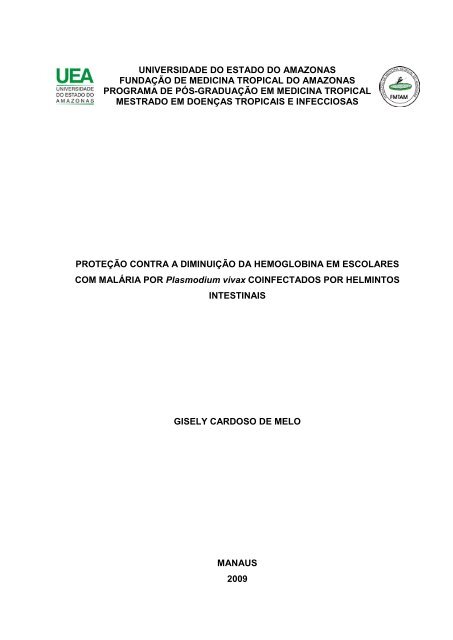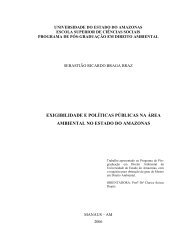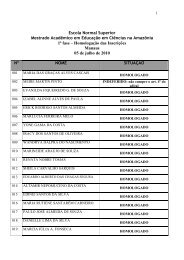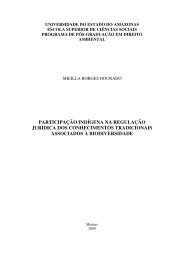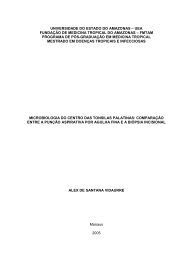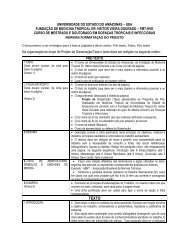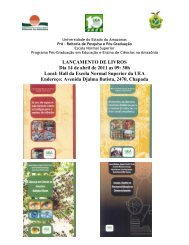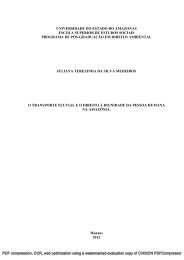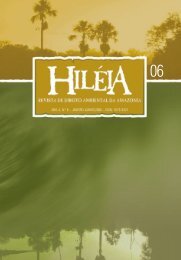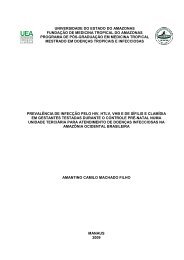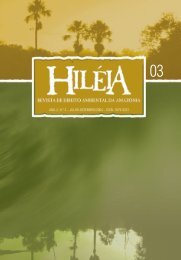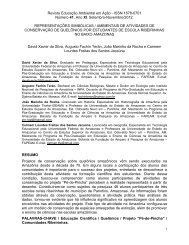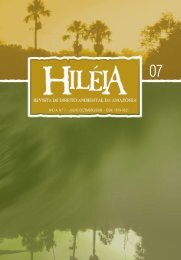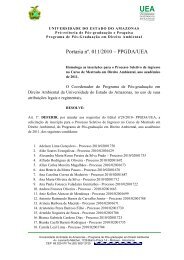Gisely Cardoso de Melo - uea - pós graduação
Gisely Cardoso de Melo - uea - pós graduação
Gisely Cardoso de Melo - uea - pós graduação
You also want an ePaper? Increase the reach of your titles
YUMPU automatically turns print PDFs into web optimized ePapers that Google loves.
UNIVERSIDADE DO ESTADO DO AMAZONASFUNDAÇÃO DE MEDICINA TROPICAL DO AMAZONASPROGRAMA DE PÓS-GRADUAÇÃO EM MEDICINA TROPICALMESTRADO EM DOENÇAS TROPICAIS E INFECCIOSASPROTEÇÃO CONTRA A DIMINUIÇÃO DA HEMOGLOBINA EM ESCOLARESCOM MALÁRIA POR Plasmodium vivax COINFECTADOS POR HELMINTOSINTESTINAISGISELY CARDOSO DE MELOMANAUS2009
iGISELY CARDOSO DE MELOPROTEÇÃO CONTRA A DIMINUIÇÃOk DA HEMOGLOBINA EM ESCOLARESCOM MALÁRIA POR Plasmodium vivax COINFECTADOS POR HELMINTOSINTESTINAISDissertação apresentada aoPrograma <strong>de</strong> Pós-Graduação emMedicina Tropical da Universida<strong>de</strong> doEstado do Amazonas em Convêniocom a Fundação <strong>de</strong> MedicinaTropical do Amazonas, paraobtenção do título <strong>de</strong> Mestre emDoenças Tropicais e Infecciosas.Orientador: Prof. Dr. Marcus Vinícius Guimarães <strong>de</strong> LacerdaMANAUS2009
FICHA CATALOGRAFICA<strong>Melo</strong>, <strong>Gisely</strong> <strong>Cardoso</strong> <strong>de</strong>Proteção contra a diminuição da hemoglobina em escolares contra a diminuição dahemoglobina em escolares com malária por Plasmodium vivax coinfectados porhelmintos intestinais. <strong>Gisely</strong> <strong>Cardoso</strong> <strong>de</strong> <strong>Melo</strong>. - Manaus, 2009.vii, 54pDissertação (Mestrado) – Universida<strong>de</strong> do Estado do Amazonas. Programa <strong>de</strong> Pós<strong>graduação</strong>em Doenças Tropicais e Infecciosas.Título em inglês: Protection against hemoglobin <strong>de</strong>crease in schoolchildrenwith Plasmodium vivax malaria and concurrent intestinal helminthic infection.1. Plasmodium vivax. 2. Ascaris lumbricoi<strong>de</strong>s. 3. Hookworm. 4. Trichuris trichiura,5.Crianças. 6.Hemoglobin.
viLISTA DE FIGURASFigura 1 Município <strong>de</strong> Careiro, Estado do Amazonas....................................... 06Figura 2 Imagem Land Sat, <strong>de</strong>stacando-se a localização do Projeto <strong>de</strong>Assentamento Agrícola Panelão e a Comunida<strong>de</strong> Céu Azul.............. 08Figura 3 Representação esquemática do <strong>de</strong>senho do estudo.......................... 09Figura 1(artigo)Figura 2(artigo)Algoritmo do estudo, <strong>de</strong>screvendo os <strong>de</strong>talhes das criançaselegíveis, recrutadas e analisadas ………………………………………. 32Média (± erro padrão da média) da concentração da hemoglobinainicial (Hb inicial) e durante (Hb na malária) o primeiro ataque agudocausado por P. vivax em 54 escolares acompanhados <strong>de</strong> abril aNovembro <strong>de</strong> 2008, em área endêmica para malária (Município doCareiro, Amazonas, Brasil), pela <strong>de</strong>tecção <strong>de</strong> helmintos pelo exameparasitológico <strong>de</strong> fezes…….................................................................. 34
viiSUMÁRIO1 INTRODUÇÃO..................................................................................................... 012 OBJETIVOS........................................................................................................ 052.1 Geral................................................................................................................. 052.2 Específicos........................................................................................................ 053 MATERIAL E MÉTODOS.................................................................................... 063.1 Área <strong>de</strong> estudo.................................................................................................. 063.1.1 Projeto <strong>de</strong> Assentamento Panelão................................................................ 073.1.2 Comunida<strong>de</strong> Céu Azul................................................................................... 073.2 Tipo <strong>de</strong> estudo e população.............................................................................. 083.3 Desenho do estudo e procedimentos............................................................... 093.3.1 Realização da gota espessa.......................................................................... 103.3.2 Determinação <strong>de</strong> hemoglobina...................................................................... 103.3.3 Avaliação nutricional ..................................................................................... 103.3.4 Coproscopia................................................................................................... 113.3.5 Processamento e análise dos dados............................................................. 113.4 Consi<strong>de</strong>rações éticas........................................................................................ 114 RESULTADOS/DISCUSSÃO.............................................................................. 125 CONCLUSÃO...................................................................................................... 376 REFERÊNCIAS BIBLIOGRÁFICAS................................................................... 387 ANEXOS............................................................................................................. 427.1 Ficha clínica...................................................................................................... 427.2 Termo <strong>de</strong> Consentimento informado livre e esclarecido................................... 44
11 INTRODUÇÃOA malária é uma doença parasitária, febril e aguda <strong>de</strong> elevada prevalência emorbida<strong>de</strong> em diversas áreas tropicais e subtropicais do mundo (1) . É talvez a maisantiga, a mais distribuída e a mais conhecida das doenças parasitárias q<strong>uea</strong>cometem o homem. Nos últimos anos, adquiriu particular importância <strong>de</strong>vido àextensa distribuição geográfica e à sua atuação como fator limitante do crescimento<strong>de</strong>mográfico, cultural e econômico em vastas áreas do mundo, particularmente nospaíses em <strong>de</strong>senvolvimento (2) .Os agentes etiológicos da malária humana são protozoários pertencentes àclasse Sporozoa, família Plasmodiidae e ao gênero Plasmodium. São conhecidasquatro espécies: Plasmodium malariae Laveran, 1881, Plasmodium falciparumWelch, 1897, Plasmodium vivax Grassi e Feletti, 1890 e Plasmodium ovaleStephens,1922 (3, 4) . No Brasil, não há registro <strong>de</strong> autoctonia <strong>de</strong> apenas umaespécie, o P. ovale. O P. falciparum é o responsável pelas formas mais graves ecomplicadas da doença e é encontrado mais comumente nas regiões tropicais (5) .Mais <strong>de</strong> 75 % dos episódios clínicos causado pelo P. falciparum por ano concentrasena África (6) . O P. vivax é o mais amplamente distribuído pelas zonas tropicais esubtropicais do globo (2) .A malária continua sendo um gran<strong>de</strong> problema <strong>de</strong> saú<strong>de</strong> pública em muitospaíses do mundo. Há <strong>de</strong> 300 a 500 milhões <strong>de</strong> novos casos <strong>de</strong> malária, no mundo, acada ano, e estes resultam em 0,7 a 2,7 milhões <strong>de</strong> mortes (7) . Os países maisafetados são os africanos, situados ao sul do <strong>de</strong>serto do Saara, os do Su<strong>de</strong>steAsiático e os da América Latina, particularmente os situados na região da BaciaAmazônica (8) . No Brasil, no ano <strong>de</strong> 2004, quase todos os 459.013 casos eramprovenientes da região amazônica (9) .Atualmente, o P. vivax é a espécie <strong>de</strong> plasmódio mais amplamente distribuída nomundo, causando 80-90 milhões <strong>de</strong> casos anuais. Nas Américas e na Ásia, é aespécie mais prevalente. No Brasil, P. vivax representa mais <strong>de</strong> 80% dos casosclínicos notificados anualmente na região amazônica(10) . Em 2006, foramregistrados cerca <strong>de</strong> 396.000 casos <strong>de</strong> malária causada por essa espécie (11) .
2As infecções helmínticas constituem um importante problema <strong>de</strong> saú<strong>de</strong> pública,especialmente nos países em <strong>de</strong>senvolvimento. As crianças são as mais atingidas eapresentam as repercussões clínicas mais significativas da infecção. No Brasil,diversos estudos realizados em pré-escolares e escolares mostraram elevadaprevalência <strong>de</strong> parasitoses intestinais (12, 13) . Existem poucos trabalhos que se<strong>de</strong>dicam ao estudo das infecções helmínticas na Região Amazônica. Em estudorealizado no Estado do Acre, verificou-se que 32,5% das crianças possuíamparasitoses intestinais (14) . Em outro estudo, realizado em Santa Isabel do Rio Negro,no Estado do Amazonas, 44% das crianças infectadas tinham carga parasitária entre5-50.000 ovos/g <strong>de</strong> fezes (15) .É estimado que um terço da população mundial que vive em regiões tropicais esubtropicais está infectada por helmintos e por uma ou mais espécies <strong>de</strong> plasmódio(6) . Os helmintos mais freqüentes nestas associações são os geo-helmintos comoAscaris lumbricoi<strong>de</strong>s, Trichuris trichiura e ancilostomí<strong>de</strong>os (16) . Estudos preliminaressugerem que um quarto <strong>de</strong> crianças em ida<strong>de</strong> escolar na África estão em risco <strong>de</strong>infecção por ancilostomí<strong>de</strong>o e P. falciparum (17) . Porém, pouco se conhece sobre omecanismo pelo qual um parasita afeta a imunida<strong>de</strong> ou a patogênese um do outro. Aubiqüida<strong>de</strong> <strong>de</strong>stes parasitos resulta em altas freqüências <strong>de</strong> co-infecção (18) .Infecções por helmintos po<strong>de</strong>m alterar a susceptibilida<strong>de</strong> para malária (19) , o que temsuscitado numerosos estudos sobre esta co-infecção, apesar <strong>de</strong>, em sua maioria,estudarem apenas a infecção por P. falciparum (20-23) .Em experimentos laboratoriais realizados em animais <strong>de</strong> experimentação, osresultados são conflitantes. Em estudo realizado em ratos co-infectados comSchistosoma mansoni e Plasmodium chabaudi, verificou-se que a parasitemiamalárica era maior em ratos co-infectados do que em ratos apenas com P. chabaudi(24) . Porém, em outro estudo, constatou-se que S. mansoni protege os ratos da formaletal da infecção por P. chabaudi pelo aumento da produção <strong>de</strong> intérferon γ (INF γ )(25) .Existem vários estudos realizados em seres humanos, na África, que chamam aatenção para a forte associação entre infecção helmíntica e malária (26-30) . Infecçãohelmíntica po<strong>de</strong> amenizar (28, 29) ou exacerbar a severida<strong>de</strong> da malária (22, 31) . Em
4São poucos os estudos com pacientes infectados por P. vivax, em parte porqueesta espécie não está relacionada freqüentemente com casos fatais. Entretanto, agravida<strong>de</strong> clínica por esta espécie tem aumentado nos últimos anos em váriaspartes do planeta e a necessida<strong>de</strong> <strong>de</strong> conhecer a interação <strong>de</strong>sta infecção tãoinci<strong>de</strong>nte entre nós com outras infecções sabidamente espoliantes é <strong>de</strong> extremanecessida<strong>de</strong>, especialmente na população em ida<strong>de</strong> pediátrica.Existem poucos estudos, que avaliaram a associação entre malária e infecçõeshelmínticas como causa <strong>de</strong> anemia em população infantil. A literatura,especialmente no Brasil, não apresenta dados sobre a associação <strong>de</strong> malária einfecção por helmintos em crianças, justificando trabalhos que possam contribuirpara aumentar o conhecimento acerca da realida<strong>de</strong> local, com novos subsídios parao estabelecimento <strong>de</strong> estratégias <strong>de</strong> prevenção e controle <strong>de</strong>ste agravo.Os trabalhos existentes apontam para a importância da associação existenteentre infecções helmínticas e malária nas crianças, especialmente aquelas commalária vivax. Além das orientações já estabelecidas em relação à importância doacesso rápido ao tratamento a<strong>de</strong>quado na prevenção das formas graves da doença,sugere-se que a monitorização do nível <strong>de</strong> hemoglobina po<strong>de</strong> ser importante naavaliação do impacto das infecções helmínticas sobre a anemia causada pelo P.vivax, justificando, mais uma vez, a realização <strong>de</strong>ste trabalho.
52 OBJETIVOS2.1 GeralAvaliar a influência das helmintoses intestinais sobre a concentração <strong>de</strong>hemoglobina em crianças com malária por Plasmodium vivax, em área rural, nomunicípio do Careiro, Estado do Amazonas.2.2 Específicos- Verificar se existe diferença na concentração <strong>de</strong> hemoglobina nos casos <strong>de</strong> maláriavivax aguda com e sem helmintose intestinal.- Verificar o estado nutricional.- Verificar a freqüência <strong>de</strong> helmintose intestinal em crianças com malária porPlasmodium vivax.
7O P. A. Panelão, criado pelo INCRA em 1998, localiza-se na BR 319 (Manaus-Porto Velho), km 117, no município do Careiro. É um ramal <strong>de</strong> 9 km divididos em 6vicinais, com aproximadamente 462 indivíduos residindo na área atualmente. Possuicomo ativida<strong>de</strong> econômica a agricultura. Como fonte <strong>de</strong> alimento os moradoresutilizam a caça e a pesca, além da agricultura familiar. O assentamento nãoapresenta água encanada, energia elétrica, coleta <strong>de</strong> lixo e saneamento básico. Aágua utilizada pelos moradores provém <strong>de</strong> cacimba ou igarapé. As vicinais que dãoacesso às moradias não são pavimentadas. As moradias são construídas <strong>de</strong>ma<strong>de</strong>ira e não apresentam forro. O assentamento é cercado por mata nativa oumodificada.3.1.2 Comunida<strong>de</strong> Céu AzulA comunida<strong>de</strong> Céu Azul localiza-se na BR 319 (Manaus-Porto Velho), km 140, noMunicípio do Careiro. Apresenta aproximadamente 328 indivíduos residindo na áreaatualmente. Possui como ativida<strong>de</strong> econômica a agricultura. Como fonte <strong>de</strong> alimentoos moradores utilizam a caça e a pesca, além da agricultura familiar. A comunida<strong>de</strong>não apresenta esgoto, coleta <strong>de</strong> lixo e saneamento básico; possui energia elétrica easfalto. A água utilizada pelos moradores provém <strong>de</strong> cacimba ou igarapé. Asmoradias são construídas <strong>de</strong> ma<strong>de</strong>ira sem forro ou <strong>de</strong> palha.
93.3 Desenho do estudo e procedimentosFigura 3- Representação esquemática do <strong>de</strong>senho do estudo.Em abril <strong>de</strong> 2008, realizou-se uma avaliação transversal para a busca ativa <strong>de</strong>casos <strong>de</strong> malária, pelo exame da gota espessa, <strong>de</strong>terminação da concentraçãoinicial <strong>de</strong> hemoglobina e avaliação nutricional. As crianças que apresentaram maláriareceberam tratamento <strong>de</strong> acordo com o Manual <strong>de</strong> Rotinas da Fundação <strong>de</strong>Medicina Tropical do Amazonas. Os escolares foram acompanhados <strong>de</strong> abril anovembro <strong>de</strong> 2008 para a <strong>de</strong>tecção passiva do primeiro episódio <strong>de</strong> malária. Nesteperíodo, dos que apresentaram malária por P. vivax, à microscopia óptica, foicoletado material para exame parasitológico <strong>de</strong> fezes e para <strong>de</strong>terminação daconcentração <strong>de</strong> hemoglobina final. As crianças que tiveram mais <strong>de</strong> um episódio <strong>de</strong>malária no período foram incluídas apenas a primeira vez. Os escolares q<strong>uea</strong>presentaram malária por P. falciparum, fizeram uso <strong>de</strong> antiparasitário ou nãoentregaram três amostras <strong>de</strong> fezes foram excluídas da análise. Para eliminarpotenciais fatores <strong>de</strong> confundimento, pacientes com hemoglobinopatias, <strong>de</strong>ficiência
124 RESULTADOSO resultado e discussão <strong>de</strong>ste trabalho estão apresentados na forma <strong>de</strong> artigocientífico, apresentado a seguir, segundo as normas <strong>de</strong> publicação da Plos One,uma vez que o artigo foi publicado nesta revista.
18Diagnosis of Malaria and Parasitemia QuantitationThick blood smear was prepared as recommen<strong>de</strong>d by the Walker technique[23] and evaluated by a local microscopist. The sli<strong>de</strong>s were sent to Manaus andreviewed by an experienced microscopist, who confirmed the species and<strong>de</strong>termined the peripheral parasitemia, quantifying the asexual forms per 100leukocytes counted in high-magnification fields, using an estimate of 5,000leukocytes/mm 3 for each child. Parasitemia was quantified as asexual parasites/mm 3 .Nutritional Status AssessmentWeight and height were obtained by internationally recommen<strong>de</strong>d methods, asfollows. Weight was measured by use of a digital scale and height was assessed withthe help of a tape. Body Mass In<strong>de</strong>x (BMI) was calculated using the program EPI-INFO 3.4.3. BMI Z-score < -2 was <strong>de</strong>fined as malnutrition, scores between -2 and Z 2 asobesity [24].Stool ExaminationThe search for hookworm, Ascaris lumbricoi<strong>de</strong>s and Trichuris trichiura wasperformed by examination of three samples of stool from each child, collected onalternate days. A single researcher performed all the exams, in or<strong>de</strong>r to avoi<strong>de</strong>xaminer’s bias. The stool samples were stored in flasks containing 10% formalin aspreservative. Flasks were labeled with the patient's name, date of collection and keptat room temperature until the end of the month, when all the stool samples wereexamined. Spontaneous sedimentation [25] and centrifugal-flotation in zinc sulphate
19solution [26] methods were applied before the samples were analyzed by directobservation with a microscope.Hemoglobin ConcentrationHemoglobin concentration was measured in venous blood obtained fromdigital puncture, using a portable HemoCue ® photometer (Anglholm, Swe<strong>de</strong>n).Statistical AnalysesData were analyzed using SPSS ® version 16.0 for Windows (SPSS Inc. ®Chicago, IL, USA). Normal distribution of data was evaluated with the Kolmogorov-Smirnov test. Chi-square or Fisher's test was used to test differences in proportions,and Stu<strong>de</strong>nt t test was used to test differences in means. Non-parametricSpearman’s test was used for the correlation analyses. A Kaplan-Meier survivalanalysis was performed in or<strong>de</strong>r to <strong>de</strong>tect differences in the time elapsed from thebaseline cross-sectional to the first malarial episo<strong>de</strong> between children with andwithout intestinal helminthes. Log-rank test was used to test differences. Statisticalsignificance was consi<strong>de</strong>red if p
20ResultsDuring the six-month follow-up interval, from 236 eligible children, 216 wereenrolled in the cohort, as seen in the algorithm in Figure 1.In Table 1, it is shown that no significant differences were observed in sex,age, nutritional status, baseline hemoglobin and/or parasitemia between the groupswith and without each helminth. Children parasitized with hookworm and Trichuristrichiura had mothers with a significantly higher level of education as compared to thenon-parasitized.Figure 2 shows no significant difference between the mean of baselinehemoglobin and the mean of hemoglobin during the acute P. vivax attack in childrenco-infected with Ascaris lumbricoi<strong>de</strong>s (p=0.221), hookworm (p=0.353) and Trichuristrichiura (p=0.976). For schoolchildren with P. vivax infection without thesehelminthes at stool examination, the mean of hemoglobin during the acute malarialattack was significantly lower than the mean of the baseline hemoglobin for all thehelminths (p
22population was already using antipyretics when they presented to the local healthpost. Using clinical severity in general as an endpoint of protection conferred byhelminths in the case of P. vivax infection would not be appropriate in our field study,in an unstable transmission area, where no child nee<strong>de</strong>d hospitalization or diedduring the course of the study. Further studies are nee<strong>de</strong>d focusing in patients fromtertiary care centers, where clinical severity is more common [43,44].The influence of helminthic infections on malaria is not entirely straightforward.In Madagascar, it was observed that infection by A. lumbricoi<strong>de</strong>s is associated withlower parasitemia in P. falciparum malaria [20,21]. However, in Senegal, the rate ofmalarial attack was higher among children co-infected with S. mansoni [45] and anassociation between A. lumbricoi<strong>de</strong>s infection and severe malaria was foun<strong>de</strong>lsewhere, <strong>de</strong>spite of the loose <strong>de</strong>finition of severity in this particular case [46]. InThailand, it was observed that helminth infections are associated with increasedinci<strong>de</strong>nce of P. falciparum [18]. In our study, the <strong>de</strong>gree of asexual parasitemia by P.vivax was not different between children with and without helminthiasis. This isprobably because they were diagnosed very early (diagnostic tests are available foreveryone at no cost in the community) and also because P. vivax lacks the<strong>de</strong>velopment of high parasitemia due to its selective reticulocyte invasion. In childrenwith severe falciparum malaria, co-infection with helminthes lea<strong>de</strong>d to the <strong>de</strong>creasein circulating reticulocyte counts [47]. Therefore, helminthes may also influence P.vivax-triggered anemia through the reduction of reticulocytes, although this issue wasnot addressed in our study. The presence of helminthes contributed to a lack ofassociation between parasitemia and hemoglobin in this group, suggesting thathelminthes may modulate the impact of parasitemia upon anemia. Recently, it wasshown that the frequency of CD4+CD25+FoxP3+ regulatory T cells correlates with P.
23vivax parasitemia [48]. However, another study has shown that the presence ofhelminthes associates with a suppressive Treg activity in vitro for P. falciparum [49].Further studies are nee<strong>de</strong>d to confirm this speculation. Children with P. falciparuminfection or mixed infection (P. vivax/P. falciparum) were not analyzed as acomparator group due to the small number of cases. An active case <strong>de</strong>tection <strong>de</strong>sign(using thick blood smear and PCR, and children without malaria as a control group)could additionally i<strong>de</strong>ntify if intestinal helminths are able to confer protection againstthe clinical manifestations of the disease and/or the state of asymptomatic carrier ofthe parasite.Despite evi<strong>de</strong>nce that malaria/intestinal helminthiasis co-infection increasesthe risk of anemia, little is known about the impact of co-infection on anemia amongstdifferent age groups [32]. In preschool, co-infection was associated with a lowerhemoglobin concentration as compared to children without malaria [50]. This controlgroup (children without malaria) was not evaluated in our study. Amongschoolchildren, hemoglobin was lower in the co-infected as opposed to children withonly one infection [51]. However, no significant difference was observed amongpregnant women, although single infections by malaria or hookworm had an impacton the concentration of hemoglobin [52]. It is important to emphasize that all thesestudies were performed using a cross-sectional study <strong>de</strong>sign. This poses somedifficulty in the comparison with our data. The likelihood that these differences maybe distinct in each age group is also very high, because anemia due to P. vivaxinfection is mostly seen in children un<strong>de</strong>r 5 years of age [44]. Children this youngwere not enrolled in our study.Surprisingly, not even hookworm infection was associated with a <strong>de</strong>crease inthe hemoglobin concentration in children with malaria. Due to the anemic effect of
24this helminth per se, we expected that in this group anemia would be more severe.However, it is important to note that in all the groups children sometimes had morethan one helminth at stool examination, precluding an isolated analysis. Due to thelack of a professional who could perform the Kato-Katz technique in the field toquantify the intestinal helminth load in fresh stool, we could not evaluate for thepotential effects of intensity of helminth infection. Further studies should explore thisaspect.A clear bias of this study could have been the longer time elapsed from thebaseline cross-sectional until the first malarial episo<strong>de</strong> in children without intestinalhelminthes, subjected therefore to other <strong>de</strong>terminants of anemia. However, for everystudied helminth, this time was very similar, what additionally suggests that intestinalhelminthes do not contribute to P. vivax clinical protection.It was noted that helminthes protect against the reduction of hemoglobinduring acute malarial attacks by P. vivax. To our knowledge, this is the first report to<strong>de</strong>monstrate the impact of helminthic co-infection on a complication triggered by P.vivax, based on a cohort study. The mechanism by which helminthes apparentlyprotect against a <strong>de</strong>crease in hemoglobin in vivax malaria is unknown. Onespeculates that high levels of the Th2 cytokines (IL-10) during helminth infectioncounteract the Th1 cytokines (TNF) induced by malaria to prevent the <strong>de</strong>velopmentof severe anemia [4]. The overall Th2/Th1 balance, the homeostatic role ofinterleukin 10 and TGF-β as modulators of the immune response [53], and the role ofthe CD23/NO pathway in reducing sequestration [17] are additional possiblemechanisms of protection against severe malaria. Other epi<strong>de</strong>miological studies arenee<strong>de</strong>d to confirm our findings with a higher number of patients, and especially inpreschool children where the effect could be more evi<strong>de</strong>nt. Studies are also
25necessary to evaluate the effect of the intensity of helminth load on the course of P.vivax infection.Competing interestsThe authors have <strong>de</strong>clared that no competing interests exist.AcknowledgmentsWe thank all the microscopists from the rural areas in the municipality ofCareiro, namely Mr. Juscelino Torres dos Santos, for his help during the collection ofstool samples.Author contributionsConceived and <strong>de</strong>signed the experiments: GCM MGCA MVGL. Performed theexperiments: GCM SVS WMM RCRL SGB MM. Analyzed the data: GCM WMMMVGL. Wrote the paper: GCM WMM MVGL.References1. WHO (2008) World malaria report 2008. Geneva.2. PAHO (2008) Malaria in the Americas: Time Series Epi<strong>de</strong>miological Data from 2000 to2007.3. McDevitt MA, Xie J, Gor<strong>de</strong>uk V, Bucala R (2004) The anemia of malaria infection: role ofinflammatory cytokines. Curr Hematol Rep 3: 97-106.4. Menen<strong>de</strong>z C, Fleming AF, Alonso PL (2000) Malaria-related anaemia. Parasitol Today 16:469-476.
265. Oliveira M (2004) Hematological characterization of children with vivax malaria in theTropical Medicine Foundation of Amazonas. Manaus: University of State of Amazonas.6. Caicedo O, Ramirez O, Mourao MP, Zia<strong>de</strong>c J, Perez P, et al. (2009) Comparativehematologic analysis of uncomplicated malaria in uniquely different regions of unstabletransmission in Brazil and Colombia. Am J Trop Med Hyg 80: 146-151.7. Boia MN, da Motta LP, Salazar MD, Mutis MP, Coutinho RB, et al. (1999) Crosssectionalstudy of intestinal parasites and Chagas' disease in the Municipality of NovoAirao, State of Amazonas, Brazil. Cad Sau<strong>de</strong> Publica 15: 497-504.8. Araujo CF, Fernan<strong>de</strong>z CL (2005) Prevalence of intestinal parasitosis in the city ofEirunepe, Amazon. Rev Soc Bras Med Trop 38: 69.9. WHO (2002) Malaria, Filariasis other parasitic diseases. Geneva.10. Tatala S, Svanberg U, Mduma B (1998) Low dietary iron availability is a major cause ofanemia: a nutrition survey in the Lindi District of Tanzania. Am J Clin Nutr 68: 171-178.11. Stephenson LS, Holland CV, Cooper ES (2000) The public health significance ofTrichuris trichiura. Parasitology 121 Suppl: S73-95.12. Stephenson LS, Latham MC, Ottesen EA (2000) Malnutrition and parasitic helminthinfections. Parasitology 121 Suppl: S23-38.13. Pearson RD (2002) An Update on the Geohelminths: Ascaris lumbricoi<strong>de</strong>s, Hookworms,Trichuris trichiura, and Strongyloi<strong>de</strong>s stercoralis. Curr Infect Dis Rep 4: 59-64.14. O'Lorcain P, Holland CV (2000) The public health importance of Ascaris lumbricoi<strong>de</strong>s.Parasitology 121 Suppl: S51-71.15. Buck AA, An<strong>de</strong>rson RI, MacRae AA (1978) Epi<strong>de</strong>miology of poly-parasitism. I.Occurrence, frequency and distribution of multiple infections in rural communities inChad, Peru, Afghanistan, and Zaire. Tropenmed Parasitol 29: 61-70.
2716. Petney TN, Andrews RH (1998) Multiparasite communities in animals and humans:frequency, structure and pathogenic significance. Int J Parasitol 28: 377-393.17. Nacher M, Gay F, Singhasivanon P, Krudsood S, Treeprasertsuk S, et al. (2000) Ascarislumbricoi<strong>de</strong>s infection is associated with protection from cerebral malaria. ParasiteImmunol 22: 107-113.18. Nacher M, Singhasivanon P, Yimsamran S, Manibunyong W, Thanyavanich N, et al.(2002) Intestinal helminth infections are associated with increased inci<strong>de</strong>nce ofPlasmodium falciparum malaria in Thailand. J Parasitol 88: 55-58.19. Brooker S, Clements AC, Hotez PJ, Hay SI, Tatem AJ, et al. (2006) The co-distribution ofPlasmodium falciparum and hookworm among African schoolchildren. Malar J 5: 99.20. Brutus L, Watier L, Briand V, Hanitrasoamampionona V, Razanatsoarilala H, et al. (2006)Parasitic co-infections: does Ascaris lumbricoi<strong>de</strong>s protect against Plasmodiumfalciparum infection? Am J Trop Med Hyg 75: 194-198.21. Brutus L, Watier L, Hanitrasoamampionona V, Razanatsoarilala H, Cot M (2007)Confirmation of the protective effect of Ascaris lumbricoi<strong>de</strong>s on Plasmodium falciparuminfection: results of a randomized trial in Madagascar. Am J Trop Med Hyg 77: 1091-1095.22. Mendis K, Sina BJ, Marchesini P, Carter R (2001) The neglected bur<strong>de</strong>n of Plasmodiumvivax malaria. Am J Trop Med Hyg 64: 97-106.23. WHO (2006) Microscopic diagnosis of Malaria. 4th edition ed. Geneva.24. Yang H, <strong>de</strong> Onis M (2008) Algorithms for converting estimates of child malnutrition basedon the NCHS reference into estimates based on the WHO Child Growth Standards. BMCPediatr 8: 19.25. Lutz A (1919) Schistosoma mansoni e a schistosomose, segundo observações feitas noBrasil. Mem Inst Oswaldo Cruz 11: 121-155.
2826. Faust EC, Sawitz W, Tobie J (1939) Comparative efficiency of various techniques for thediagnosis of protozoa and helminths in feces. J Parasitol 25: 241-262.27. WHO (2002) Reducing risks, promoting healthy life. The World Health Report 2002.Annex Table 3. Bur<strong>de</strong>n of Disease in DALYs by Cause, Sex and Mortality Stratums inWHO Regions, Estimates for 2001. Geneva.28. Brabin BJ, Hakimi M, Pelletier D (2001) An analysis of anemia and pregnancy-relatedmaternal mortality. J Nutr 131: 604S-614S; 614S-615S.29. Crawley J (2004) Reducing the bur<strong>de</strong>n of anemia in infants and young children inmalaria-en<strong>de</strong>mic countries of Africa: from evi<strong>de</strong>nce to action. Am J Trop Med Hyg 71:25-34.30. Grantham-McGregor S, Ani C (2001) A review of studies on the effect of iron <strong>de</strong>ficiencyon cognitive <strong>de</strong>velopment in children. J Nutr 131: 649S-666S; discussion 666S-668S.31. Korenromp EL, Armstrong-Schellenberg JR, Williams BG, Nahlen BL, Snow RW (2004)Impact of malaria control on childhood anaemia in Africa - a quantitative review. TropMed Int Health 9: 1050-1065.32. Brooker S, Akhwale W, Pullan R, Estambale B, Clarke SE, et al. (2007) Epi<strong>de</strong>miology ofplasmodium-helminth co-infection in Africa: populations at risk, potential impact onanemia, and prospects for combining control. Am J Trop Med Hyg 77: 88-98.33. Ndyomugyenyi R, Kabatereine N, Olsen A, Magnussen P (2008) Malaria and hookworminfections in relation to haemoglobin and serum ferritin levels in pregnancy in Masindidistrict, western Uganda. Trans R Soc Trop Med Hyg 102: 130-136.34. Stoltzfus RJ, Chwaya HM, Montresor A, Albonico M, Savioli L, et al. (2000) Malaria,hookworms and recent fever are related to anemia and iron status indicators in 0- to 5-yold Zanzibari children and these relationships change with age. J Nutr 130: 1724-1733.
2935. Nacher M, Singhasivanon P, Gay F, Silachomroon U, Phumratanaprapin W, et al. (2001)Contemporaneous and successive mixed Plasmodium falciparum and Plasmodium vivaxinfections are associated with Ascaris lumbricoi<strong>de</strong>s: an immunomodulating effect? JParasitol 87: 912-915.36. Nacher M, Singhasivanon P, Silachamroon U, Treeprasertsu S, Krudsood S, et al. (2001)Association of helminth infections with increased gametocyte carriage during mildfalciparum malaria in Thailand. Am J Trop Med Hyg 65: 644-647.37. Nacher M, Singhasivanon P, Krudsood S, Phumratanaprapin W, Vanaphan S, et al.(2005) Inverse relationship between the number of fertilized Ascaris eggs excreted andfever, in patients co-infected with Plasmodium vivax and Ascaris lumbricoi<strong>de</strong>s. Ann TropMed Parasitol 99: 623-625.38. Nacher M, Singhasivanon P, Traore B, Dejvorakul S, Phumratanaprapin W, et al. (2001)Short report: Hookworm infection is associated with <strong>de</strong>creased body temperature duringmild Plasmodium falciparum malaria. Am J Trop Med Hyg 65: 136-137.39. Briand V, Watier L, JY LEH, Garcia A, Cot M (2005) Coinfection with Plasmodiumfalciparum and Schistosoma haematobium: protective effect of schistosomiasis onmalaria in senegalese children? Am J Trop Med Hyg 72: 702-707.40. Murray MJ, Murray AB, Murray MB, Murray CJ (1977) Parotid enlargement, forehea<strong>de</strong><strong>de</strong>ma, and suppression of malaria as nutritional consequences of ascariasis. Am J ClinNutr 30: 2117-2121.41. Murray J, Murray A, Murray M, Murray C (1978) The biological suppression of malaria:an ecological and nutritional interrelationship of a host and two parasites. Am J Clin Nutr31: 1363-1366.42. Nacher M, Singhasivanon P, Silachamroon U, Treeprasertsuk S, Vannaphan S, et al.(2001) Helminth infections are associated with protection from malaria-related acuterenal failure and jaundice in Thailand. Am J Trop Med Hyg 65: 834-836.
3043. Kochar DK, Saxena V, Singh N, Kochar SK, Kumar SV, et al. (2005) Plasmodium vivaxmalaria. Emerg Infect Dis 11: 132-134.44. Tjitra E, Anstey NM, Sugiarto P, Warikar N, Kenangalem E, et al. (2008) MultidrugresistantPlasmodium vivax associated with severe and fatal malaria: a prospectivestudy in Papua, Indonesia. PLoS Med 5: e128.45. Sokhna C, Le Hesran JY, Mbaye PA, Akiana J, Camara P, et al. (2004) Increase ofmalaria attacks among children presenting concomitant infection by Schistosomamansoni in Senegal. Malar J 3: 43.46. Le Hesran JY, Akiana J, Ndiaye el HM, Dia M, Senghor P, et al. (2004) Severe malariaattack is associated with high prevalence of Ascaris lumbricoi<strong>de</strong>s infection amongchildren in rural Senegal. Trans R Soc Trop Med Hyg 98: 397-399.47. Nacher M, Singhasivanon P, Gay F, Phumratanaprapin W, Silachamroon U, et al. (2001)Association of helminth infection with <strong>de</strong>creased reticulocyte counts and hemoglobinconcentration in Thai falciparum malaria. Am J Trop Med Hyg 65: 335-337.48. Bueno LL, Morais CG, Araujo FF, Gomes JA, Correa-Oliveira R, et al. (2010)Plasmodium vivax: induction of CD4+CD25+FoxP3+ regulatory T cells during infectionare directly associated with level of circulating parasites. PLoS ONE 5: e9623.49. Wammes LJ, Hamid F, Wiria AE, <strong>de</strong> Gier B, Sartono E, et al. Regulatory T cells in humangeohelminth infection suppress immune responses to BCG and Plasmodium falciparum.Eur J Immunol 40: 437-442.50. Brooker S, Peshu N, Warn PA, Mosobo M, Guyatt HL, et al. (1999) The epi<strong>de</strong>miology ofhookworm infection and its contribution to anaemia among pre-school children on theKenyan coast. Trans R Soc Trop Med Hyg 93: 240-246.51. Stephenson LS, Latham MC, Kurz KM, Kinoti SN, Oduori ML, et al. (1985) Relationshipsof Schistosoma hematobium, hookworm and malarial infections and metrifonate
31treatment to hemoglobin level in Kenyan school children. Am J TropMed Hyg 34: 519-528.52. Shulman CE, Graham WJ, Jilo H, Lowe BS, New L, et al. (1996) Malaria is an importantcause of anaemia in primigravidae: evi<strong>de</strong>nce from a district hospital in coastal Kenya.Trans R Soc Trop Med Hyg 90: 535-539.53. Nacher M (2004) Interactions between worm infections and malaria. Clin Rev AllergyImmunol 26: 85-92.
32Figure 1. Algorithm of the study, <strong>de</strong>scribing the <strong>de</strong>tails of eligible, enrolled and analyzedchildren.
34Figure 2. Mean (± standard error of the mean) hemoglobin concentration before (baseline Hb) and during (malarial Hb) thefirst P. vivax acute attack in 54 schoolchildren followed from April to November 2008, in an en<strong>de</strong>mic area for malaria (Municipality ofCareiro, Amazonas, Brazil), according to the helminth <strong>de</strong>tected at stool examination.
35Figure 3. Correlation between parasitemia and hemoglobin during the first malarial attack in children without helminthes (A) andwith helminthes (B).
36Figure 4. Kaplan-Meier survival analysis showing the time elapsed from the baseline cross-sectional to the firstmalarial infection (in days) in 54 schoolchildren followed from April to November 2008, with and without Ascaris lumbricoi<strong>de</strong>s (A),hookworm (B) and Trichuris trichiura (C).
375 CONCLUSÃOObservou-se que os helmintos protegem da diminuição da hemoglobina nosepisódios <strong>de</strong> malária por P. vivax. Trata-se da primeira observação na literatura<strong>de</strong>monstrando o impacto <strong>de</strong> coinfecção helmíntica sobre uma complicação<strong>de</strong>senca<strong>de</strong>ada por P. vivax. São necessários outros estudos epi<strong>de</strong>miológicos paraconfirmarem tal achado, com maior número <strong>de</strong> pacientes, bem como em outrasáreas.O mecanismo pelo qual ocorreu a proteção contra a diminuição da hemoglobinanos indivíduos coinfectados <strong>de</strong>ve ser objeto <strong>de</strong> investigações futuras. Estas <strong>de</strong>verãoincluir o estudo do perfil imunológico humoral e/ou celular <strong>de</strong>stas duas populações<strong>de</strong> crianças.É importante discutir as implicações potenciais <strong>de</strong>sses achados na saú<strong>de</strong> públicadada a escassez <strong>de</strong> estudos. Futuros estudos com outras abordagensmetodológicas po<strong>de</strong>m melhorar o conhecimento sobre esta associação. Além disso,não se conhece como a coinfecção po<strong>de</strong> influenciar no controle integrado dashelmintoses intestinais e da malária.
386 REFERÊNCIAS BIBLIOGRÁFICAS1. Mutis MCS, Martinez-Espinosa FE, Albuquerque BC, Coura JR. Malária. In:Coura JR, editor. Dinâmica das Doenças infecciosas e parasitárias. Rio <strong>de</strong> Janeiro:Guanabara Koogan; 2005. p. 833-904.2. Ferreira MS. Malária. In: Focaccia R, editor. Veronezi: tratado <strong>de</strong> infectologia.Sâo Paulo: Editora Atheneu; 2005. p. 1589-632.3. Bruce-Chwatt LJ. Essential malariology. London: William Heinemann MedicalBooks; 1980.4. Oliveira MS. Caracterização hematológica em crianças, com malária vivax,diagnosticadas e tratadas na Fundação <strong>de</strong> Medicina Tropical do Amazonas Manaus:Universida<strong>de</strong> do Estado do Amazonas; 2004.5. Gilles HM. Morbidity and mortality from parasitic disease in the year 2000. AnnParasitol Hum Comp. 1990;65 Suppl 1:43-4.6. Snow RW, Guerra CA, Noor AM, Myint HY, Hay SI. The global distribution ofclinical episo<strong>de</strong>s of Plasmodium falciparum malaria. Nature. 2005 Mar10;434(7030):214-7.7. US. Centers for Disease Control and Prevention, 2004. A-Z In<strong>de</strong>x: Malaria.About Malaria, Malaria Facts: Global Distribution. 2004 [cited 20/08/07]; Availablefrom: www.cdc.gov/malaria/facts.htm#WorldMalaria8. OPAS. Informe <strong>de</strong> la situación <strong>de</strong> los programas <strong>de</strong> malaria en las Américas.2001 [cited 10/08/07]; Available from: www.opas.org.br9. MS. Diretoria Técnica da Gestão, Secretaria <strong>de</strong> Vigilância em Saú<strong>de</strong>,Ministério da Saú<strong>de</strong>: Situação Epi<strong>de</strong>miológica da Malária no Brasil. 2005 [cited10/08/07; Available from: www.sau<strong>de</strong>.gov.br10. MS. Investigação epi<strong>de</strong>miológica da malária no Brasil. 2002 [cited 200707/07/07]; Available from: www.sau<strong>de</strong>.gov.br11. MS. Situação epi<strong>de</strong>miológica da malária no Brasil. 2007 [cited 200820/02/08]; Available from:http://portal.sau<strong>de</strong>.gov.br/portal/arquivos/pdf/fol<strong>de</strong>r_malaria_2007_web.pdf12. Campos MR, Valencia LI, Fortes B<strong>de</strong> P, Braga RC, Medronho R<strong>de</strong> A. [Spatialdistribution of Ascaris lumbricoi<strong>de</strong>s infection]. Rev Sau<strong>de</strong> Publica. 2002Feb;36(1):69-74.13. Costa-Macedo LM, Machado-Silva JR, Rodrigues-Silva R, Oliveira LM, ViannaMSR. Enteroparasitoses em pré-escolares <strong>de</strong> comunida<strong>de</strong>s favelizadas da cida<strong>de</strong> doRio <strong>de</strong> Janeiro, Brasil. Cad Saú<strong>de</strong> Pública. 1998;14:851-55.
14. Muniz PT, Castro TG, Araujo TS, Nunes NB, Silva-Nunes M, Hoffmann EH, etal. Child health and nutrition in the Western Brazilian Amazon: population-basedsurveys in two counties in Acre State. Cad Sau<strong>de</strong> Publica. 2007 Jun;23(6):1283-93.15. Carvalho-Costa FA, Goncalves AQ, Lassance SL, Silva Neto LM, SalmazoCA, Boia MN. Giardia lamblia and other intestinal parasitic infections and theirrelationships with nutritional status in children in Brazilian Amazon. Rev Inst MedTrop Sao Paulo. 2007 May-Jun;49(3):147-53.16. Brooker S, Clements AC, Bundy DA. Global epi<strong>de</strong>miology, ecology and controlof soil-transmitted helminth infections. Adv Parasitol. 2006;62:221-61.17. Brooker S, Clements AC, Hotez PJ, Hay SI, Tatem AJ, Bundy DA, et al. Theco-distribution of Plasmodium falciparum and hookworm among Africanschoolchildren. Malar J. 2006;5:99.18. Petney TN, Andrews RH. Multiparasite communities in animals and humans:frequency, structure and pathogenic significance. Int J Parasitol. 1998 Mar;28(3):377-93.19. Nacher M. Malaria vaccine trials in a wormy world. Trends Parasitol. 2001Dec;17(12):563-5.20. Nacher M, Gay F, Singhasivanon P, Krudsood S, Treeprasertsuk S, Mazier D,et al. Ascaris lumbricoi<strong>de</strong>s infection is associated with protection from cerebralmalaria. Parasite Immunol. 2000 Mar;22(3):107-13.21. Sokhna C, Le Hesran JY, Mbaye PA, Akiana J, Camara P, Diop M, et al.Increase of malaria attacks among children presenting concomitant infection bySchistosoma mansoni in Senegal. Malar J. 2004 Nov 15;3:43.22. Spiegel A, Tall A, Raphenon G, Trape JF, Druilhe P. Increased frequency ofmalaria attacks in subjects co-infected by intestinal worms and Plasmodiumfalciparum malaria. Trans R Soc Trop Med Hyg. 2003 Mar-Apr;97(2):198-9.23. Brooker S, Akhwale W, Pullan R, Estambale B, Clarke SE, Snow RW, et al.Epi<strong>de</strong>miology of plasmodium-helminth co-infection in Africa: populations at risk,potential impact on anemia, and prospects for combining control. Am J Trop MedHyg. 2007 Dec;77(6 Suppl):88-98.24. Helmby H, Kullberg M, Troye-Blomberg M. Altered immune responses in micewith concomitant Schistosoma mansoni and Plasmodium chabaudi infections. InfectImmun. 1998 Nov;66(11):5167-74.25. Yoshida A, Maruyama H, Kumagai T, Amano T, Kobayashi F, Zhang M, et al.Schistosoma mansoni infection cancels the susceptibility to Plasmodium chabaudithrough induction of type 1 immune responses in A/J mice. Int Immunol. 2000Aug;12(8):1117-25.39
26. Brutus L, Watier L, Briand V, Hanitrasoamampionona V, Razanatsoarilala H,Cot M. Parasitic co-infections: does Ascaris lumbricoi<strong>de</strong>s protect against Plasmodiumfalciparum infection? Am J Trop Med Hyg. 2006 Aug;75(2):194-8.27. Brutus L, Watier L, Hanitrasoamampionona V, Razanatsoarilala H, Cot M.Confirmation of the Protective Effect of Ascaris lumbricoi<strong>de</strong>s on Plasmodiumfalciparum Infection: Results of a Randomized Trial in Madagascar. Am J Trop MedHyg. 2007 Dec;77(6):1091-5.28. Nacher M, Singhasivanon P, Silachamroon U, Treeprasertsuk S, VannaphanS, Traore B, et al. Helminth infections are associated with protection from malariarelatedacute renal failure and jaundice in Thailand. Am J Trop Med Hyg. 2001Dec;65(6):834-6.29. Nacher M, Singhasivanon P, Traore B, Dejvorakul S, Phumratanaprapin W,Looareesuwan S, et al. Short report: Hookworm infection is associated with<strong>de</strong>creased body temperature during mild Plasmodium falciparum malaria. Am J TropMed Hyg. 2001 Aug;65(2):136-7.30. Nacher M. Comment on: Severe malaria attack is associated with highprevalence of Ascaris lumbricoi<strong>de</strong>s infection among children in rural Senegal. TransR Soc Trop Med Hyg. 2005 Feb;99(2):161-3; discussion 4-5.31. Le Hesran JY, Akiana J, Ndiaye el HM, Dia M, Senghor P, Konate L. Severemalaria attack is associated with high prevalence of Ascaris lumbricoi<strong>de</strong>s infectionamong children in rural Senegal. Trans R Soc Trop Med Hyg. 2004 Jul;98(7):397-9.32. Briand V, Watier L, JY LEH, Garcia A, Cot M. Coinfection with Plasmodiumfalciparum and Schistosoma haematobium: protective effect of schistosomiasis onmalaria in senegalese children? Am J Trop Med Hyg. 2005 Jun;72(6):702-7.33. Shapiro AE, Tukahebwa EM, Kasten J, Clarke SE, Magnussen P, Olsen A, etal. Epi<strong>de</strong>miology of helminth infections and their relationship to clinical malaria insouthwest Uganda. Trans R Soc Trop Med Hyg. 2005 Jan;99(1):18-24.34. Hotez PJ, Brooker S, Bethony JM, Bottazzi ME, Loukas A, Xiao S. Hookworminfection. N Engl J Med. 2004 Aug 19;351(8):799-807.35. Nacher M, Singhasivanon P, Gay F, Phumratanaprapin W, Silachamroon U,Looareesuwan S. Association of helminth infection with <strong>de</strong>creased reticulocytecounts and hemoglobin concentration in Thai falciparum malaria. Am J Trop MedHyg. 2001 Oct;65(4):335-7.36. Nkuo-Akenji TK, Chi PC, Cho JF, Ndamukong KK, Sumbele I. Malaria andhelminth co-infection in children living in a malaria en<strong>de</strong>mic setting of mountCameroon and predictors of anemia. J Parasitol. 2006 Dec;92(6):1191-5.37. Lhanos C, Flórez MH, Arévalo-Herrera M, Herrera S. Mecanismos <strong>de</strong>generación <strong>de</strong> anemia em malaria. Colomb Med. 2004;35:205-14.40
38. Korenromp EL, Armstrong-Schellenberg JR, Williams BG, Nahlen BL, SnowRW. Impact of malaria control on childhood anaemia in Africa -- a quantitative review.Trop Med Int Health. 2004 Oct;9(10):1050-65.39. Menen<strong>de</strong>z C, Fleming AF, Alonso PL. Malaria-related anaemia. ParasitolToday. 2000 Nov;16(11):469-76.40. Kahigwa E, Schellenberg D, Sanz S, Aponte JJ, Wigayi J, Mshinda H, et al.Risk factors for presentation to hospital with severe anaemia in Tanzanian children: acase-control study. Trop Med Int Health. 2002 Oct;7(10):823-30.41. Carneiro IA, Drakeley CJ, Owusu-Agyei S, Mmbando B, Chandramohan D.Haemoglobin and haematocrit: is the threefold conversion valid for assessinganaemia in malaria-en<strong>de</strong>mic settings? Malar J. 2007;6:67.42. Neves DP. Parasitologia Humana. 10ª ed. São Paulo: Editora Atheneu; 2001.41
427 ANEXOSINFLUÊNCIA DAS HELMINTOSES INTESTINAIS SOBRE A CONCENTRAÇÃODE HEMOGLOBINA EM CRIANÇAS COM MALÁRIA POR Plasmodium vivaxEM ASSENTAMENTO RURAL, NA AMAZÔNIA BRASILEIRADissertação <strong>de</strong> MestradoAluna responsável: <strong>Gisely</strong> <strong>Cardoso</strong> <strong>de</strong> <strong>Melo</strong>FICHA CLÍNICAData <strong>de</strong> inclusão: ........ / ........ / ........NúmeroIDENTIFICAÇÃONome:..........................................................................................................................................Registro:Cor/Raça: 1-branca 2-parda 3-preta 4-indígena 5-amarela........Data <strong>de</strong> nascimento: .......... / .......... / ..........Pai:Ida<strong>de</strong>: ............ anos....................................Gênero: 1-M 2-F........................................................................................................................................................................................................................Mãe:.....................................................................................................................................................................................................................Residência:....................................................................................................................................................................................................Escola:................................................................................................................................................................................................................CARACTERÍSTICAS INDIVIDUAISLocal provável <strong>de</strong> infecção:............................................................................................................................................................1-Careiro 2- Manaus 3-Outro estado ........ Qual? .....................................................................Há quanto tempo vive em área endêmica? 1-< 6m 2-6m-1a 3-1a-2a 4-2a-3a 5->3a .......Já teve malária? 1-sim 2-não ....... Última vez há ..................... mesesTipo: 1-V 2-F 3-F+V 4-não sabe ........Número <strong>de</strong> episódios prévios <strong>de</strong> malária: 1- 1-3 2- 4-6 3- 7-10 4- >10 .......Já ficou internado com malária? 1-sim 2-não .......Uso <strong>de</strong> alguma medicação antimalárica nos últimos 60 dias? 1-sim 2-não .......Qual?..........................................................................................................................................................................................................................Está apresentando diarréia? 1-sim 2-não .......
43Já fez exame <strong>de</strong> fezes? 1-sim 2-não .......Já teve verminose? 1-sim 2-não .......Uso <strong>de</strong> alguma medicação antiparasitária ultimamente? 1-sim 2-não .......Qual?..................................................................................................................................................................................................................EXAME DA GOTA ESPESSAExame 1- Data: ........../............./...........Tipo <strong>de</strong> malária: 1- V 2- F 3- negativo ............Parasitemia: 1-
44Etiqueta com o código <strong>de</strong>pesquisa do pacienteTermo <strong>de</strong> consentimento informado livre e esclarecidoNOME DA PESQUISAINFLUÊNCIA DAS HELMINTOSES INTESTINAIS SOBRE A CONCENTRAÇÃODE HEMOGLOBINA EM CRIANÇAS COM MALÁRIA POR Plasmodium vivaxEM ÁREA RURAL, NA AMAZÔNIA BRASILEIRAPatrocinadores:Universida<strong>de</strong> do Estado do Amazonas (UEA)Fundação <strong>de</strong> Medicina Tropical do Amazonas (FMT-AM)Equipe responsável:<strong>Gisely</strong> <strong>Cardoso</strong> <strong>de</strong> <strong>Melo</strong> (Bioquímica)Dr. Marcus Vinícius Guimarães <strong>de</strong> Lacerda (Médico)Dra Maria das Graças Costa Alecrim (Médica)OBJETIVO E DESCRIÇÃO DO ESTUDOEste é um estudo que estamos fazendo na Escola Municipal Fred Fernan<strong>de</strong>s da Silva e na EscolaMunicipal Antônia Oliveira da Silva, com o objetivo <strong>de</strong> avaliar a influência dos vermes sobre aanemia em crianças com malária por Plasmodium vivax.A malária é uma doença transmitida pela picada do carapanã, <strong>de</strong>s<strong>de</strong> as 6 horas da tar<strong>de</strong> até as 6horas da manhã. No Brasil existem dois tipos <strong>de</strong> malária: a malária vivax e a malária falciparum.Nos dois tipos, o paciente po<strong>de</strong> ter só febre, mas também po<strong>de</strong> morrer se não for tratado.A picada do carapanã(Anopheles darlingi) po<strong>de</strong>transmitir a malária vivaxou falciparum durante anoite.Às vezes a malária po<strong>de</strong> causar anemia nas crianças o que po<strong>de</strong> favorecer o <strong>de</strong>senvolvimento damalária grave.
45A malária po<strong>de</strong> darfebre, mal-estar,calafrios, vômitos,diarréia e atésangramento napele, nariz ou naboca.Para po<strong>de</strong>rmos estudar a associação entre verminoses e malária vivax nas crianças,precisamos acompanhar durante 6 meses a criança na escola. Realizaremos os exames <strong>de</strong>dosagem <strong>de</strong> hemoglobina, fezes e malária.Para isso, é preciso que sejam colhidos, além da gota <strong>de</strong> sangue do <strong>de</strong>do para o exame da malária,mais uma gota <strong>de</strong> sangue do <strong>de</strong>do para <strong>de</strong>terminação da anemia e amostra <strong>de</strong> fezes para realizaçãodo exame parasitológico <strong>de</strong> fezes.Depois que os resultados dos exames estiverem prontos, o responsável pela criança que participarda pesquisa po<strong>de</strong>rá ver estes resultados, que ficarão sob a responsabilida<strong>de</strong> dos pesquisadores.Os remédios para malária, que são <strong>de</strong> distribuição gratuita, vão <strong>de</strong>pen<strong>de</strong>r do tipo da malária e dagravida<strong>de</strong> do caso. Se a malária for grave, a criança po<strong>de</strong>rá ser encaminhada ao Hospital Tropical.As crianças que apresentarem alguma verminose receberão também tratamento gratuito.QUAIS SÃO OS BENEFÍCIOS EM PARTICIPAR DA PESQUISA?Além <strong>de</strong> ter uma equipe especializada em malária que vai acompanhar o aluno (a) durante todo oano letivo, ao participar <strong>de</strong>ste estudo, ela não receberá qualquer benefício adicional, nemganhará dinheiro, mas estará contribuindo para o estudo <strong>de</strong>sta doença, que ainda mata muitaspessoas.Se a criança tiver algum prejuízo participando da pesquisa, os pesquisadores po<strong>de</strong>rão lhe ajudar<strong>de</strong> alguma maneira, basta conversar com eles !!!!!
46QUEM VAI FICAR SABENDO DO RESULTADO DOS EXAMES?A participação nesse estudo será confi<strong>de</strong>ncial e os resultados dos exames serão mostrados àspessoas do Hospital Tropical que trabalham com malária, mas o nome da criança que participarnunca será revelado.O QUE ACONTECE SE O RESPONSÁVEL OU A CRIANÇA QUISER DESISTIR DE PARTICIPARDA PESQUISA?A criança que participar da pesquisa tem todo o direito <strong>de</strong> dizer que não quer mais participar. Emesmo que isso aconteça, a criança será tratada e terá direito ao atendimento no Hospital Tropicalcaso precisar.ATENÇÃO: NENHUM PESQUISADOR PODE DEIXAR DE TRATAR BEM A CRIANÇA CASORESPONSÁVEL OU ELA MESMA DIGA QUE NÃO QUER ENTRAR NA PESQUISA OU QUERERSAIR DELA, DEPOIS DE ALGUNS DIAS!!!!EU GUARDAREI COMIGO ALGUM PAPEL DIZENDO QUE A CRIANÇA PARTICIPOU DAPESQUISA?O responsável que permitir que a criança participe da pesquisa assinará duas cópias <strong>de</strong>stedocumento, uma cópia ficará com o pesquisador, na Gerência <strong>de</strong> Malária, e a outra ficará com oresponsável.E O QUE FAZER SE ACONTECER ALGUMA COISA COM A CRIANÇA DEPOIS DA PESQUISA?Para qualquer esclarecimento ou ajuda, o paciente po<strong>de</strong>rá falar com o Presi<strong>de</strong>nte do Comitê <strong>de</strong>Ética em Pesquisa do Hospital Tropical (grupo <strong>de</strong> pessoas que avalia os projetos <strong>de</strong> pesquisa quesão realizados em um hospital): Dr. Luiz Carlos <strong>de</strong> Lima Ferreira (Telefone: 238-1711, ramal 319)ou com a farmacêutica-bioquímica abaixo:A farmacêutica-bioquímica <strong>Gisely</strong> <strong>Cardoso</strong> <strong>de</strong> <strong>Melo</strong>, cujonúmero <strong>de</strong> telefone é 9159-8604, terá disponibilida<strong>de</strong> paraaten<strong>de</strong>r e esclarecer quaisquer dúvidas.


